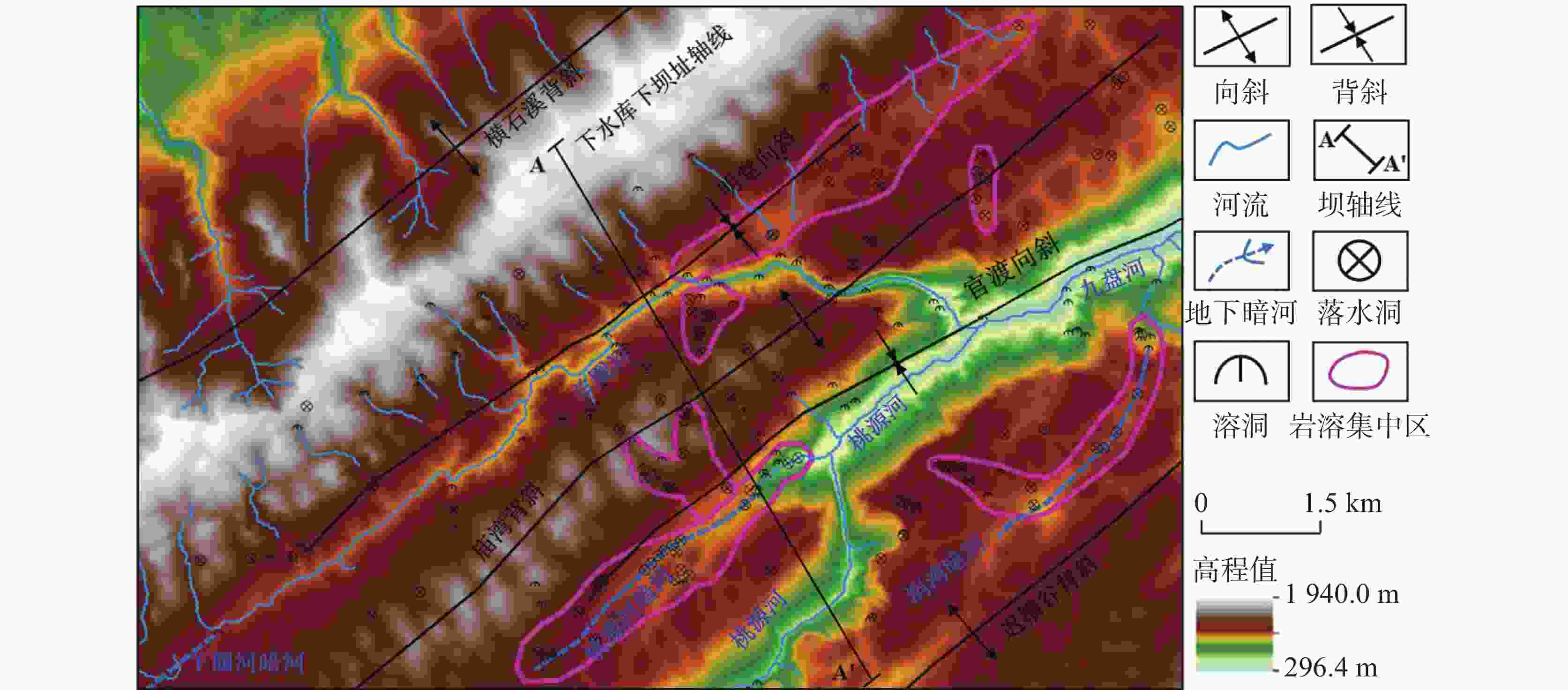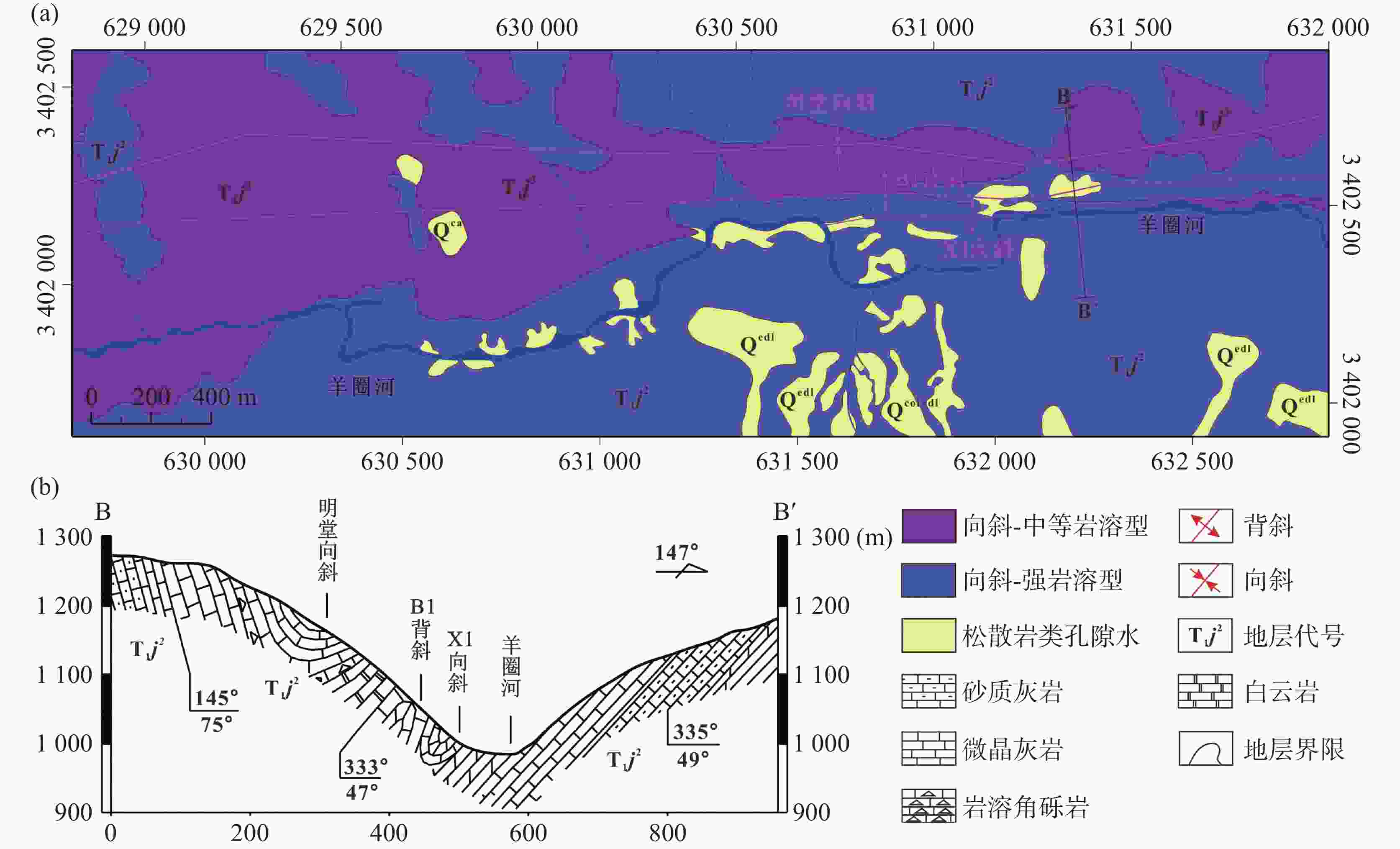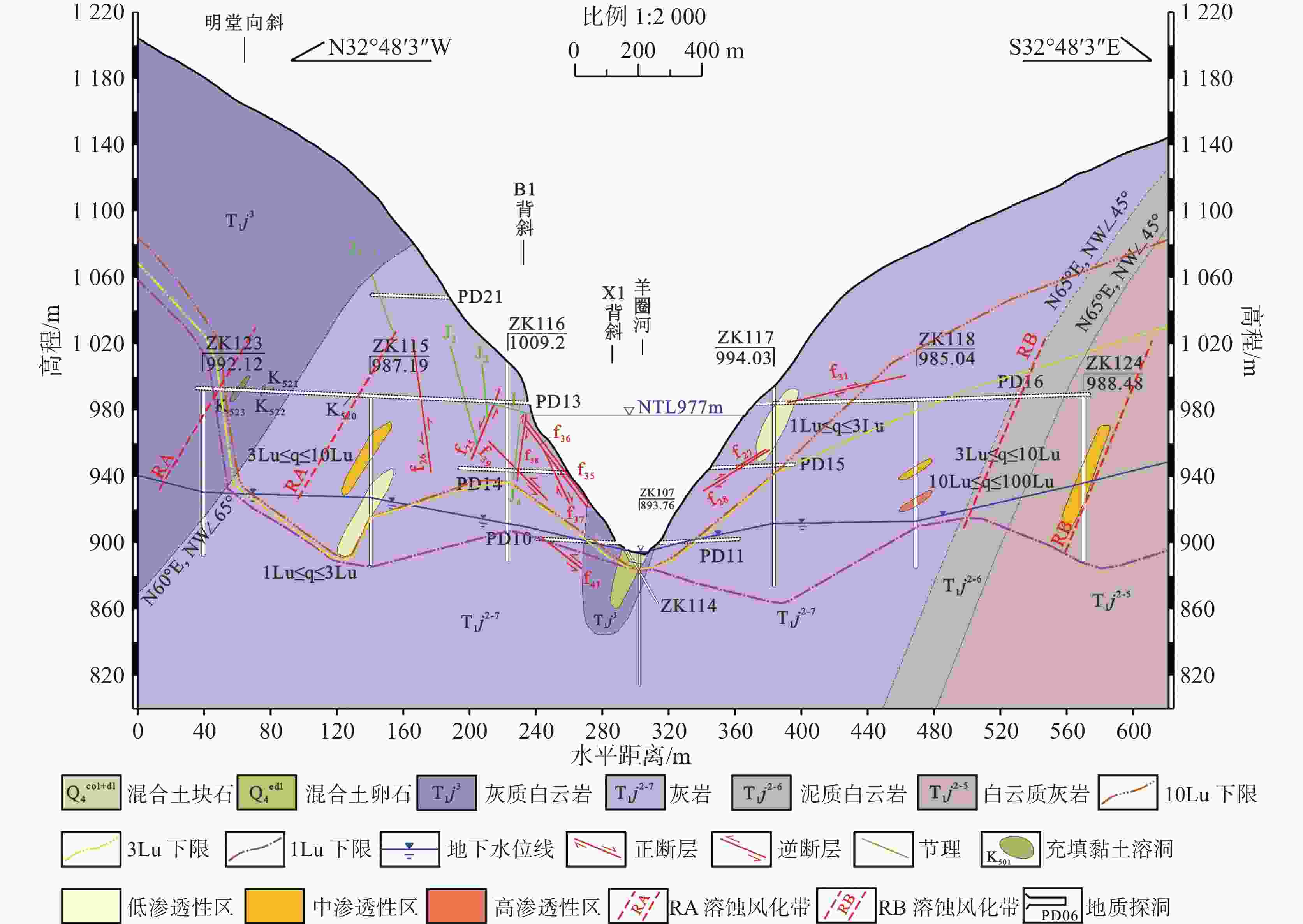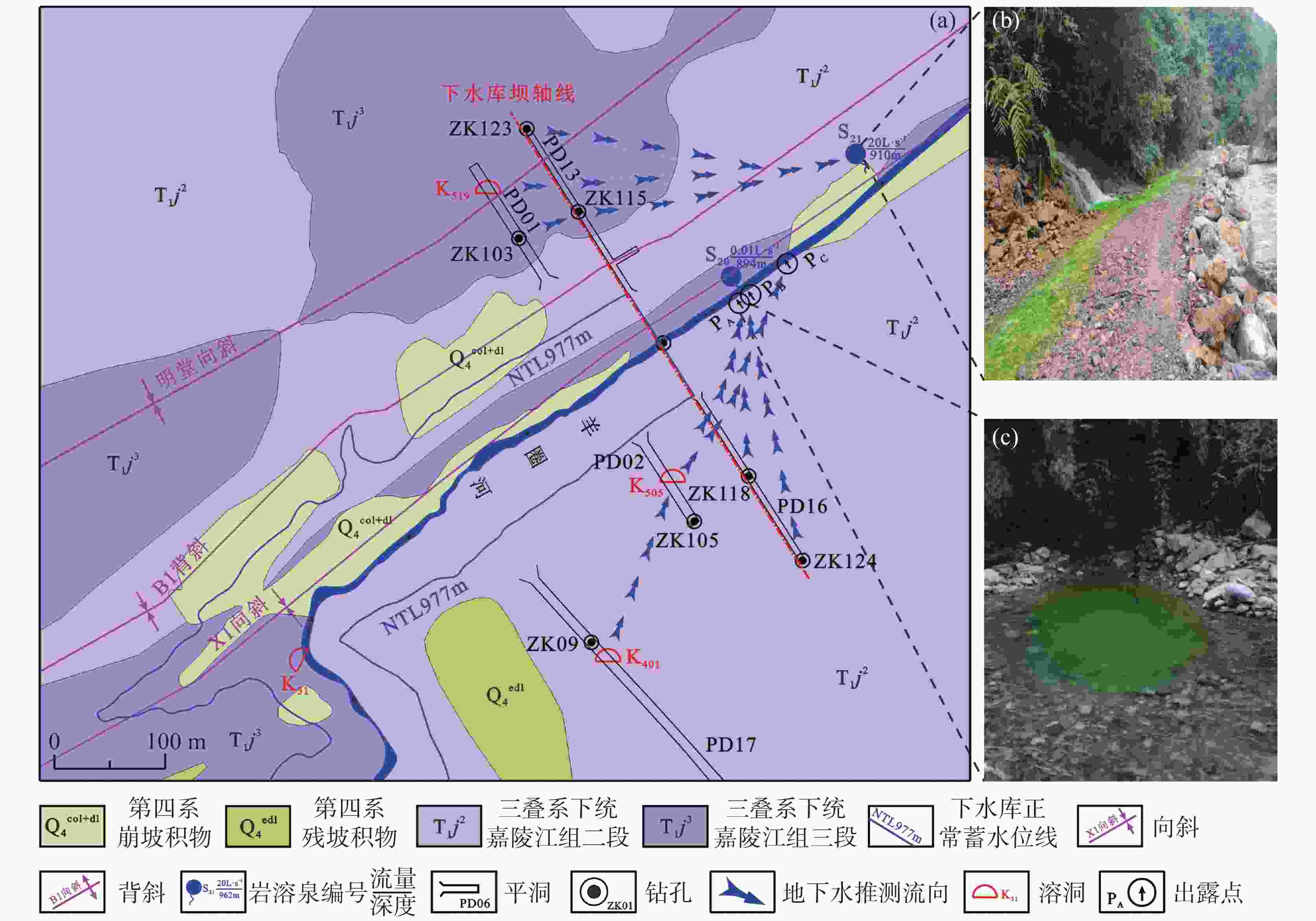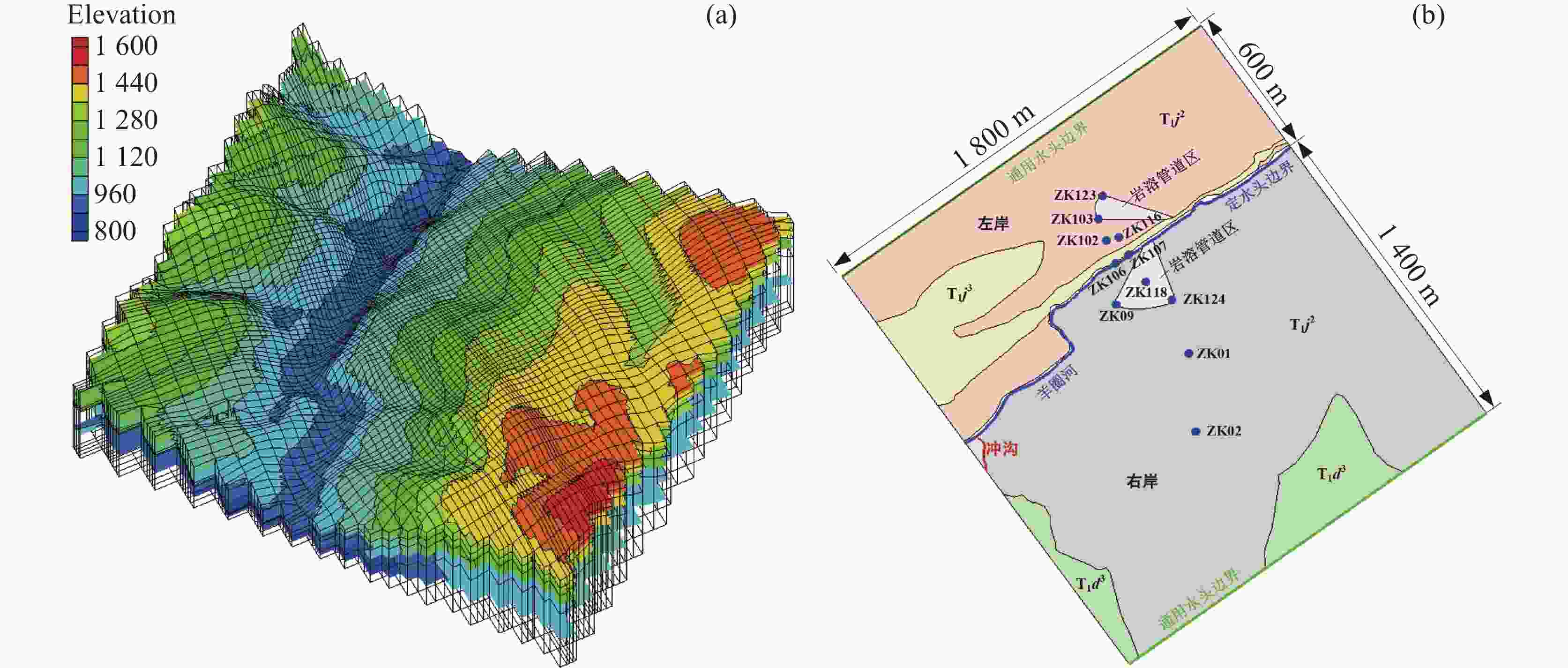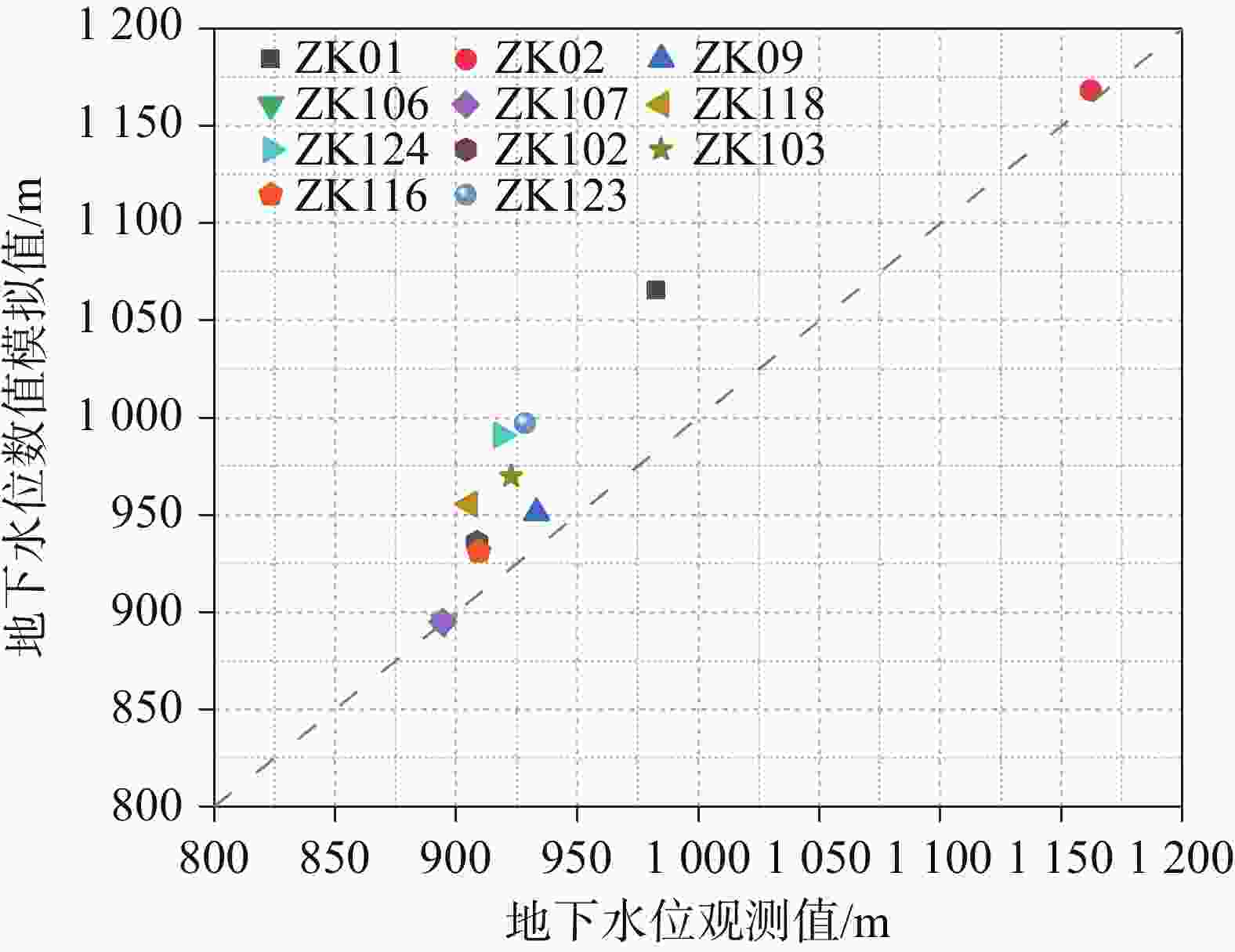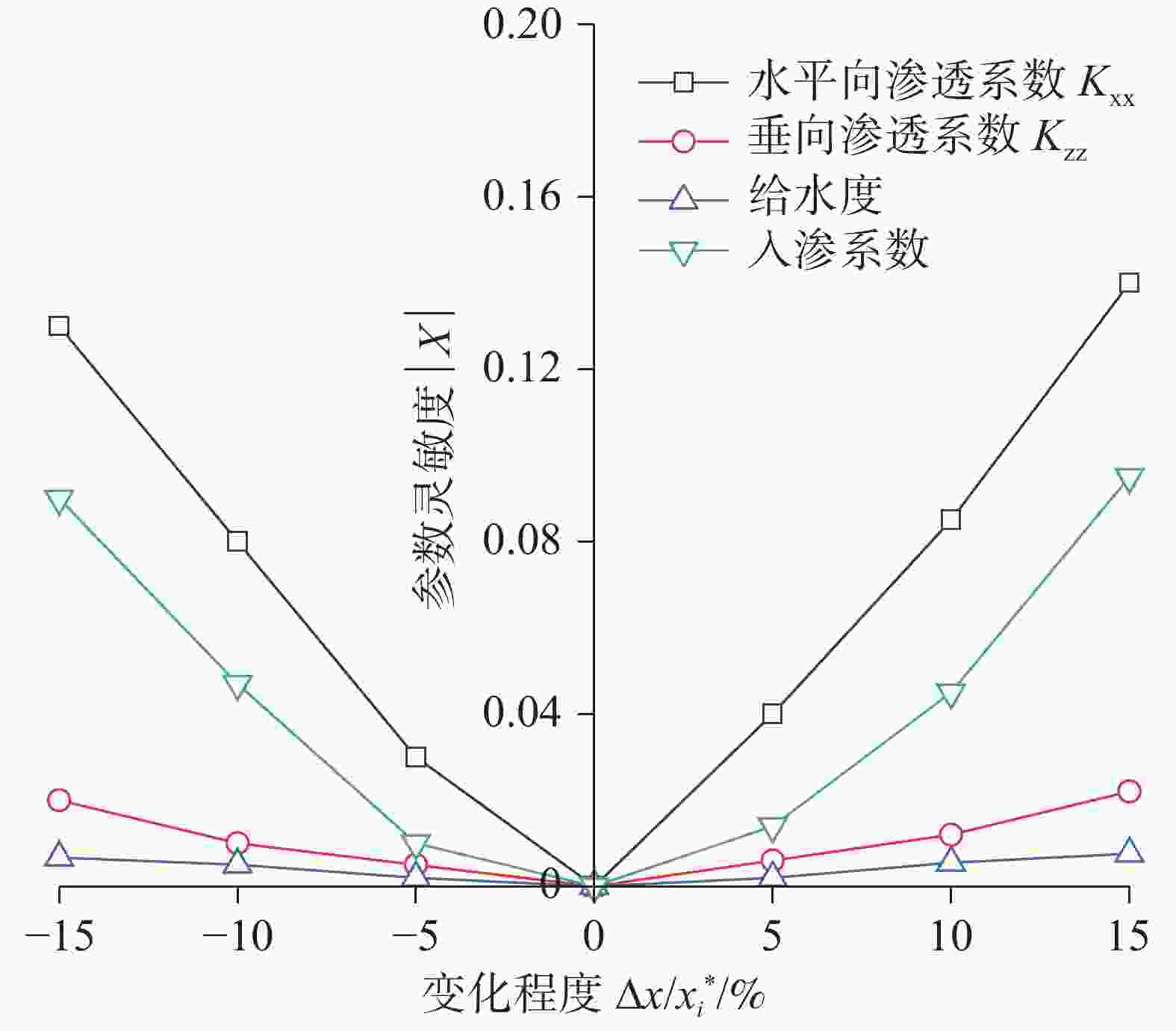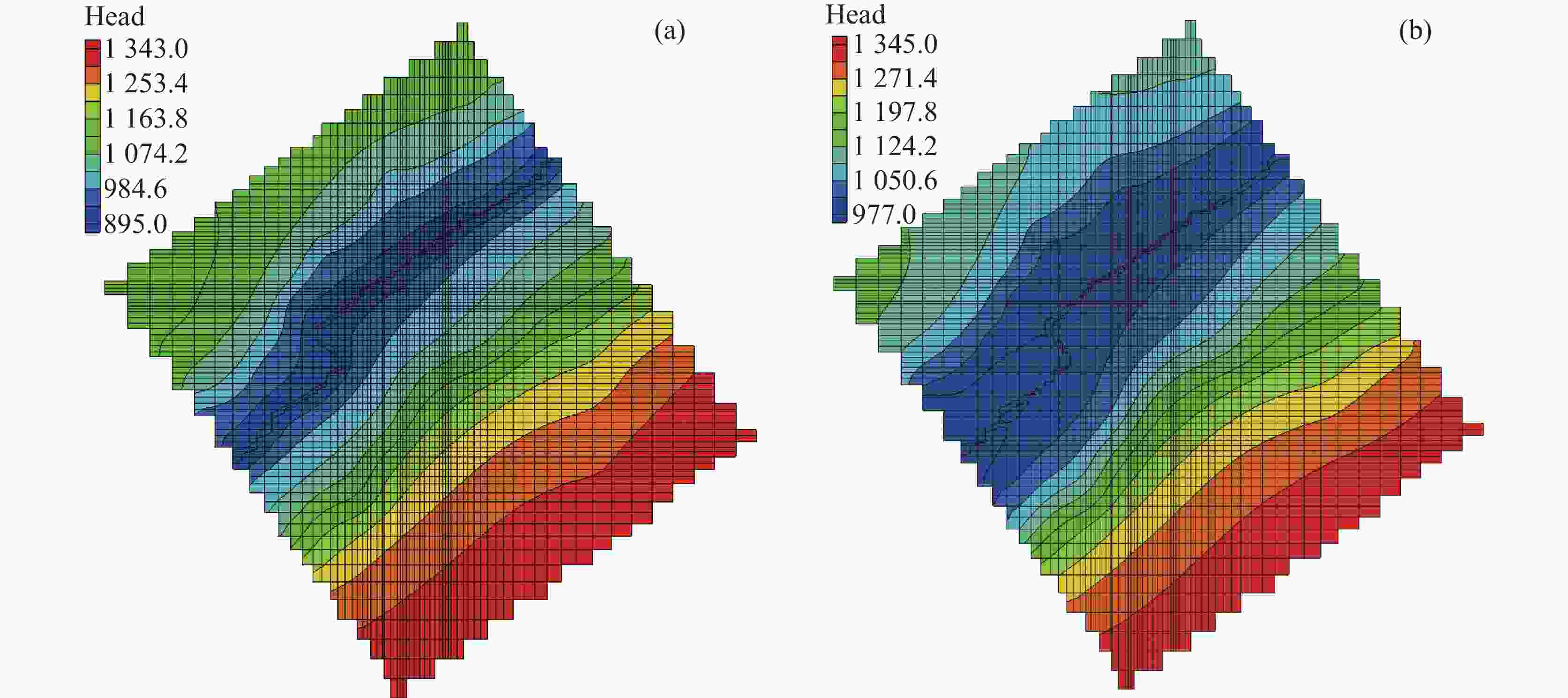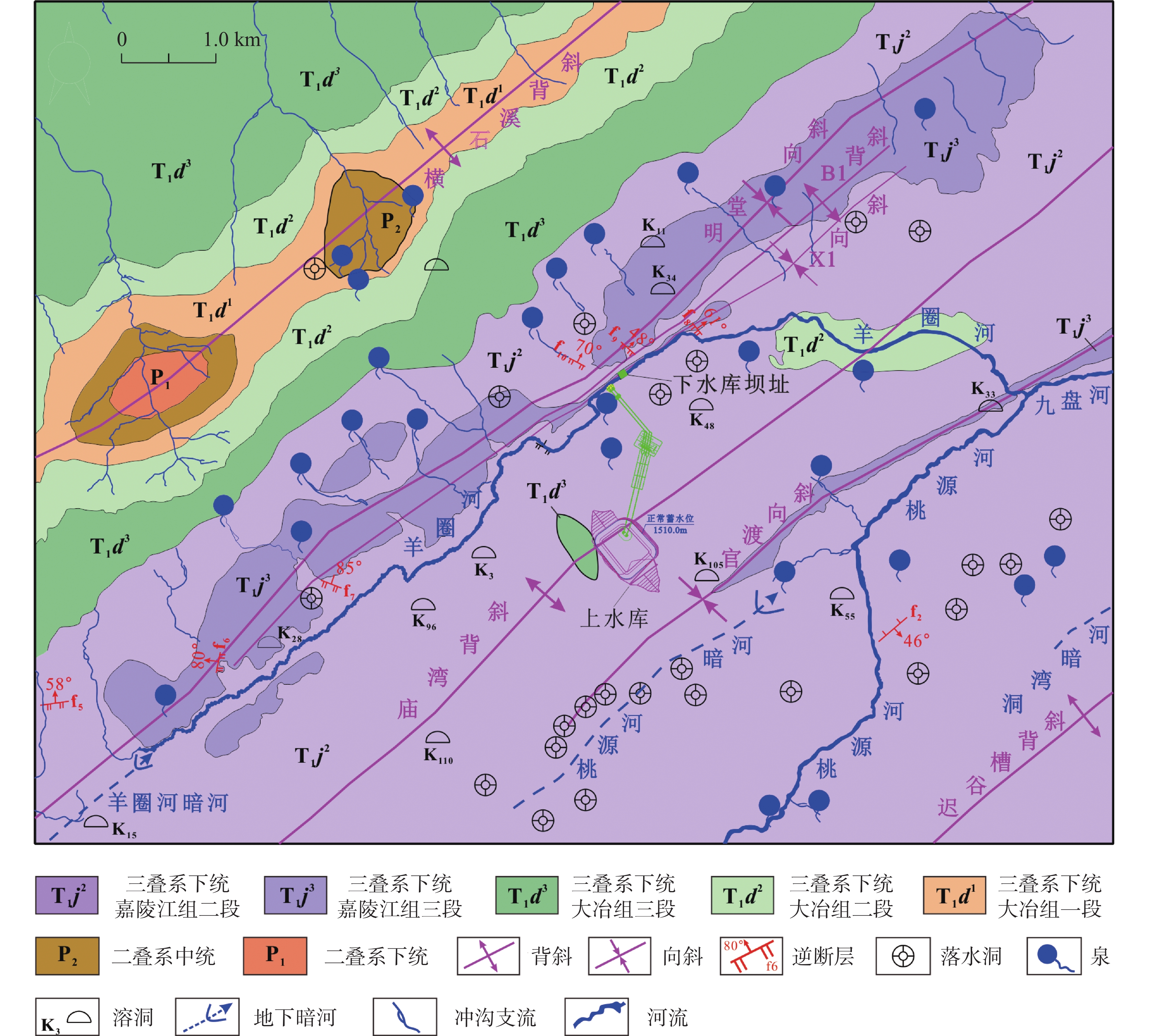Evaluation of karst hydrogeological conditions and reservoir leakage analysis in the basin of Yangquan River, Fengjie County, Chongqing City
-
摘要: 重庆奉节羊圈河流域地形陡峭,岩溶水文地质条件复杂,岩溶渗漏成为抽水蓄能电站建设的突出问题。本文利用地质调查测绘、水文地质试验、岩溶水系统分析、数值模拟以及解析计算等多种方法,评价了羊圈河流域岩溶水文地质条件,系统地分析了羊圈河成库过程中岩溶渗漏类型、渗漏位置、渗漏通道以及渗漏量。结果表明:羊圈河流域岩溶主要集中在碳酸盐岩高纯度带、构造裂隙发育带、排泄基准面附近,且发育程度随地表深度的增加而逐渐降低,形成了表部岩溶强发育和内部岩溶弱发育的双重壳核结构;岩溶水系统为典型的西南背斜山地岩溶裂隙−管道−地下河类型,在空间上可划分为背斜−强岩溶型、向斜−强岩溶型和向斜−中等岩溶型三类;羊圈河成库过程中在坝基和左右岸可能发生溶隙型、管道型以及管道-裂隙型三种渗漏类型;解析解和数值模拟结果表明羊圈河成库过程中可能会发生严重的坝基和绕坝渗漏,亟需高效合理的防渗控制措施来处理左右岸岩溶地下水管道系统以达到建坝成库条件。Abstract:
Southwest China constitutes the world's largest karst region with concentrated exposure and distribution of carbonate rocks.Within this area, Chongqing City is a pivotal component of the southwestern karst system, with karst landscapes covering approximately 30,000 km2, primarily concentrated in the northeastern and southeastern of Chongqing City. This region has experienced multiple phases of strong karstification, resulting in well-developed karst landforms such as solution caves, sinkholes, karst springs, and underground rivers. Abundant surface water and groundwater have triggered frequent karst geohazards, including reservoir leakage, water inrush in tunnels, and karst collapses. These events have seriously constrained the safety construction of hydraulic projects and local economic development. The Yangquan River basin in Fengjie County, Chongqing City covers an area of approximately 45.5 km2, with a total river length of about 14 km. The daily average river water level is 895.1 m, while the average annual flow is 0.686 m3∙s−1, corresponding to a average annual runoff of 21.63 million m3. The basin has a subtropical warm and humid monsoon climate, characterized by an average annual precipitation of 1163.1 mm, an average annual evaporation of1267.8 mm, and an average annual temperature of 18.7 ℃. Limestone and dolomite strata are developed in the basin, with undeveloped and small-scale faults located on the slopes of both banks. In contrast, fold structures are extensively developed, generally trending parallel to the Yangquan River. The left bank of the Yangquan River exhibits multiple gullies controlled by lithology and NW-trending fold structures. The topographic divide is the Jinfeng Mountain with elevations ranging from1800 m to 1900 m. The right bank constitutes an interstream block between the Yangquan River and the Taoyuan River, characterized by a topographic divide elevation of approximately1450 ~1600 m. Therefore, the left and right banks of the Yangquan River have steep topography, forming a typical “V”-shaped longitudinal valley. Overall, the karst hydrogeological conditions are complex, and karst leakage has become a crucial issue in the construction of pumped storage power stations in this area.This paper evaluates the karst hydrogeological conditions of Yangquan River basin by using geological survey and mapping, hydrogeological field experiments, and karst water system analysis. Subsequently, the karst leakage type, karst leakage location, and karst leakage passage are systematically analyzed during the impoundment of the Yangquan River reservoir. Ultimately, the three-dimensional seepage filed of the Yangquan River under natural and impounding conditions are conducted by using MODFLOW software. The karst leakage rates are calculated and validated through numerical modelling and analytical formulas. The results show that in the Yangquan River basin, karst development is mainly concentrated in the high-purity zone of carbonate rocks, structural fracture development zone, and discharge base level, forming five concentrated zones that exhibit a northeast-trending banded distribution. The degree of karst development gradually decreases with the increase of depth, exhibiting significant elevation zoning characteristics. This results in a dual shell-core structure characterized by strong karst development on the surface and weak karst development internally. Moreover, the karst groundwater system in the Yangquan River is a typical type of karstic fissure-tube-underground river system in the anticline mountainous of Southwest China, which can be spatially divided into strong karst anticline zone, strong karst syncline zone, and moderate karst syncline zone. Based on the water balance theory, the karst groundwater system in the site is classified as a secondary hydrogeological unit, namely II-2 interstream block. The recharge, runoff, and discharge modes of karst groundwater in the basin are primarily characterized by rainfall infiltration and concentrated drainage through longitudinal-transverse conduit-fissure flow systems. Packer tests and groundwater tracer tests indicate that the left bank of the Yangquan River develops an interconnected karst conduit system, while the right bank exhibits a dual-media system composed of fissure networks and karst conduits. During the impoundment of the lower reservoir in the Yangquan River, pore leakage may occur at the dam foundation, while karstic tube leakage and karstic tube-fissure coupling leakage may develop on the both left and right banks; however, there will be no leakage in the lower adjacent valley. The analytical solutions for the pore leakage and karstic tube leakage are 9505.13 m3∙d−1 and117979.20 m3∙d−1, respectively. As a comparison, the numerical result of karst leakage is approximately12184.60 m3∙d−1, indicating that more efficient and reasonable numerical methods and anti-seepage control measures need to be adopted to address karst groundwater tube system on both banks to achieve the conditions for dam construction and reservoir formation. This study can provide some suggestions for hydraulic projects in Southwest China.-
Key words:
- Karst water system /
- reservoir leakage /
- numerical simulation /
- analytical solutions /
- Yangquan River
-
图 9 羊圈河下水库地下水示踪试验示意图: (a) 岩溶管道地下水推测流向; (b) 左岸岩溶泉S21; (c)出露点PA (下游河谷80 m)
Figure 9. Schematic diagram of groundwater tracing tests in the lower reservoir in the Yangquan River: (a) Predicted groundwater flow direction in karst pipelines, (b) karst spring S21, and (c) point PA in river valley 80 m away from the dam axis
表 1 羊圈河流域岩溶类型基本特征
Table 1. Basic characteristics of karst in the Yangquan River basin
岩溶类型 位置 构造部位 分布地层 发育高程/m 形态特征 溶洞 左右岸坡谷;冲沟沟坡和沟头 明堂向斜北西翼和南
东翼;X1向斜近核部T1d3,T1j2,
T1j3900~977(占比18.6%)
977~1440 (占比81.4%)多顺层发育,发育方向N60°E~N80°E,洞径2~30 m,深度多大于3 m,少数发育岩溶泉。 落水洞 左岸岭脊;右岸谷坡;冲沟沟口
和沟头明堂向斜北西翼;
B1背斜核部T1j2 1000 ~1300 (占比4.5%)1300 ~1500 (占比95.5%)沿北东向纵张和北西向横张陡倾节理发育,洞径0.5~5 m,探深3~200 m。 岩溶泉 左右岸谷坡;冲沟沟头和沟口;河道转弯处 明堂向斜北西翼;
B1背斜核部和南东翼;
X1向斜近核部T1d3,T1j2 910~977(占比18.5%)
977~1650 (占比81.5%)大多数为岩溶泉,少量为岩溶裂隙水,流量0.1~30 L∙s−1,呈常流状态,受枯季影响小,正常蓄水位以下岩溶泉5个(S21、S23、S29、S30、S82)。 地下暗河 上游谷底河源 明堂向斜核部 T1j2 1100 沿北东向主控褶皱构造方向发育,最大流量可达130 L∙s−1,露头于地层
交界处。表 2 地下水示踪试验安排表
Table 2. List of groundwater tracing tests
试验
编号投放点 具体
位置投放试剂
量/kg投放
时间接收到
时间时间间
隔/min直线距
离/m接收点 1 K519 左岸平洞PD01 5.0 2022.10.07 /17:50:002022.10.08 /12:00:001100 350 岩溶泉S21 2 K519 左岸平洞PD13 6.0 2022.07.26 /11:00:002022.07.27 /5:00:001080 270 岩溶泉S21 3 ZK115 左岸坝肩 5.0 2022.09.26 /12:00:002022.09.27 /12:30:001470 250 岩溶泉S21 4 ZK123 左岸坝肩 5.0 2022.09.29 /11:40:002022.09.29 /17:00:00320 300 岩溶泉S21 5 ZK103 左岸坝肩 4.0 2022.07.29 /14:00:002022.07.30 /9:00:001140 340 岩溶泉S21 6 ZK118 右岸坝肩 5.0 2022.09.26 /11:40:002022.09.29 /10:00:004220 180 出露点PA和PB 7 ZK124 右岸坝肩 5.0 2022.10.11 /11:00:002022.10.16 /7:50:007010 280 出露点PA和PB 8 K401 右岸平洞PD17 20.0 2022.10.15 /8:30:002022.11.01 /14:00:0024810 400 出露点PA和PB 9 K505 右岸平洞PD02 5.0 2021.05.15 /12:00:002021.06.16 /8:00:001200 200 出露点PC 表 3 数值模型各渗透性分区参数取值表
Table 3. Parameter sections for five permeability zones of numerical model
模型分层 层厚 (m) 左岸 右岸 坝基 Kxx = Kyy/m∙d−1 Kzz/m∙d−1 给水度 Kxx = Kyy/m∙d−1 Kzz/m∙d−1 给水度 Kxx = Kyy/m∙d−1 Kzz/m∙d−1 给水度 强渗透性层 8.0~236.5 5.13 0.513 0.3 1.58 0.158 0.1 0.02 0.002 0.01 中等渗透性层 1.0~56.6 0.2 0.02 0.05 0.1 0.01 0.03 0.015 0.0015 0.01 低渗透性层 0.5~136.0 0.017 0.0017 0.005 0.009 0.0009 0.002 0.01 0.001 0.001 微渗透性层 64.2~317.7 0.001 0.0001 0.0001 0.001 0.0001 0.0001 0.001 0.0001 0.0001 岩溶管道区 1.0~168.0 2141.0 214.1 0.3 42.82 4.28 0.3 / / / 表 4 羊圈河流域各月份平均降雨量和平均蒸发量统计表
Table 4. Statistics of monthly average rainfall and evaporation in the Yangquan River basin
气象要素 单位 月份 年 1 2 3 4 5 6 7 8 9 10 11 12 平均降雨量 mm 16.4 23.2 54.2 98.6 161.9 166.3 183.9 136 146.8 105.6 52.2 17.8 1163.1 平均蒸发量 mm 44.6 56.4 82.5 111.9 135.4 146.7 182.1 192.7 138 84.1 55.2 38.2 1267.8 表 5 蓄水期下水库渗漏量解析公式参数选取
Table 5. Parameter sections of analytical formulas for the lower reservoir leakage during impoundment
部位 K/m∙d−1) H/m B/m T/m L/m H2/m H1/m D/m r0/m V/m·s−1·m−1 S/m2 ΔH/m 坝基 0.02 82 338 10.5 175 / / / 87.5 / / / 左岸坝肩 5.13 / / / 175 91.2 9.6 225.12 87.5 0.005 4.0 67 右岸坝肩 1.58 / / / 175 112.8 30.8 252.05 87.5 0.001 0.3 85 表 6 不同计算方法下羊圈河下水库渗漏量计算表
Table 6. The lower reservoir leakage in the Yangquan River calculated by various methods
渗漏部位 渗漏类型 解析解(m3/d) 数值解/m3∙d−1 公式(2) 公式(3) 公式(4) 合计 坝基 溶隙型渗漏 31.38 / / 31.38 53.45 左岸坝肩 绕坝溶隙型渗漏 / 6338.16 / 122114.16 8480.25 管道型渗漏 / / 115776 右岸坝肩 绕坝溶隙型渗漏 / 3135.59 / 5338.79 3650.90 管道型渗漏 / / 2203.2 -
[1] 石朋, 侯爰冰, 马欣欣, 陈喜, 张志才. 西南喀斯特流域水循环研究进展[J]. 水利水电科技进展, 2012, 32(1):69-73. doi: 10.3880/j.issn.1006-7647.2012.01.016SHI Peng, HOU Yuanbing, MA Xinxin, CHEN Xi, ZHANG Zhicai. Research progress in hydrologic cycle in karst area of Southwest China[J]. Advances in Science and Technology of Water Resources, 2012, 32(1): 69-73. doi: 10.3880/j.issn.1006-7647.2012.01.016 [2] 胡大儒, 郑克勋, 赵代尧, 陈占恒. 复杂岩溶水系统势汇区建坝成库可行性研究-以北盘江流域普岔河水库为例[J]. 中国岩溶, 2022, 41(5):736-745. doi: 10.11932/karst20220507HU Daru, ZHENG Kexun, ZHAO Daiyao, CHEN Zhanheng. Feasibility study on dam and reservoir construction in the catchment area of complex karst water system: Taking Pucha Reservoir of Beipan River as an example[J]. Carsologica Sinica, 2022, 41(5): 736-745. doi: 10.11932/karst20220507 [3] 乔依娜. 重庆岩溶区近700年土壤侵蚀演变的洼地沉积记录[D]. 重庆: 西南大学, 2024.QIAO Yina. Sedimentary records of erosion evolution inkarst area of Chongqing in the past 700 years[D]. Chongqing: Southwest University, 2024. [4] 陈洪凯, 王圣娟, 粟俊江, 胡婷. 地下水降落诱发岩溶洞穴土质盖层塌陷的机制研究—以重庆歌乐山余家湾水库地面塌陷为例[J]. 重庆师范大学学报(自然科学版), 2018, 35(4):54-58.CHEN Hongkai, WANG Shengjuan, SU Junjiang, HU Ting. Study on mechanism of ground collapse in soil cover over karst caves triggered by drop-down of underground water: taking ground collapse at Yujiawan Reservior in Mt. Gele of Chongqing City as an example[J]. Journal of Chongqing Normal University (Natural Science), 2018, 35(4): 54-58. [5] 李云. 重庆南山隧道与上覆涂山湖相互影响研究[D]. 重庆: 重庆交通大学, 2015.LI Yun. Study on the mutual influence for Chongqing Nanshan tunnel and overlying TuShan lake[D]. Chongqing: Chongqing Jiaotong University, 2015. [6] 罗鉴银, 傅瓦利. 岩溶地区开挖隧道对水资源的影响—以渝合高速公路隧道为例[J]. 西南农业大学学报(自然科学版), 2006(1):154-156+160.LUO Jianyin, FU Wali. Effects of tunnel excavation in the Zhongliang Mountains on their water resources-a case study of the tunnel of Yuhe Highway[J]. Journal of Southwest Agricultural University (Natural Science), 2006(1): 154-156+160. [7] 李近, 曹聪, 许模, 范泽英, 夏强. 重庆中梁山隧道群涌突水时空特征分析[J]. 人民长江, 2023, 54(9):119-127+135.LI Jin, CAO Cong, XU Mo, FAN Zeying, XIA Qiang. Spatio-temporal characteristics of groundwater inrush in Zhongliang tunnel group in Chongqing City[J]. Yangtze River, 2023, 54(9): 119-127+135. [8] 李潇, 漆继红, 许模. 西南典型紧窄褶皱小尺度浅层岩溶水系统特征及隧道涌水分析[J]. 中国岩溶, 2020, 39(3):375-383. doi: 10.11932/karst2020y32LI Xiao, QI Jihong, XU Mo. Analysis on the characteristics of small-scale shallow karst water systems intypical tight-narrow folds and tunnel water inrush in southwestern China[J]. Carsological Sinica, 2020, 39(3): 375-383. doi: 10.11932/karst2020y32 [9] 周正, 李大华, 廖云平, 林军志, 张烨, 陈洪凯, 祁永爱, 王贺. 重庆中梁山岩溶地面塌陷特征及形成机理[J]. 中国岩溶, 2022, 41(1):67-78. doi: 10.11932/karst20220103ZHOU Zheng, LI Dahua, LIAO Yunping, ZHANG Hua, CHEN Hongkai, QI Yongai, WANG He. Characteristics and formation mechanism of karst ground collapse in Zhongliangshan area, Chongqing[J]. Carsological Sinica, 2022, 41(1): 67-78. doi: 10.11932/karst20220103 [10] 吴远斌, 殷仁朝, 雷明堂, 戴建玲, 贾龙, 潘宗源, 马骁, 周富彪. 重庆中梁山地区隧道工程影响下岩溶塌陷形成演化模式及防治对策[J]. 中国岩溶, 2021, 40(2):246-252. doi: 10.11932/karst20210204WU Yuanbin, YIN Renchao, LEI Mingtang, DAI Jianling, JIA Long, PAN Zongyuan, MA Xiao, ZHOU Fubiao. Triggering factors and prevention-control countermeasures of karst collapsescaused by tunnel construction in the Zhongliangshan area, Chongqing[J]. Carsological Sinica, 2021, 40(2): 246-252. doi: 10.11932/karst20210204 [11] 胡婷. 重庆地区地下工程建设诱发岩溶塌陷的机制研究[D]. 重庆: 重庆交通大学, 2014.HU Ting. Study on the mechanism of karst collapse induced by underground engineering construction in Chongqing[D]. Chongqing: Chongqing Jiaotong University, 2014. [12] 沈春勇, 余波, 郭维祥. 水利水电工程岩溶勘察与处理[M]. 北京: 中国水利水电出版社, 2015.SHEN Chunyong, YU Bo, GUO Weixiang. Karst survey and treatment of water conservancy and hydropower engineering[M]. Beijing: China Water & Power Press, 2015. [13] 韩行瑞. 岩溶水文地质学[M]. 北京: 地质出版社, 2015.HAN Xingrui. Karst Hydrogeology[M]. Beijing: Geological Publishing House, 2015. [14] 曾荣福, 郑克勋, 王钦权. 岩溶水库渗透破坏型渗漏勘察与评价[J]. 中国岩溶, 2023, 42(1):119-127. doi: 10.11932/karst2021y29ZENG Rongfu, ZHENG Kexun, WANG Qinquan. Investigate and evaluation of the leakage caused by seepage failure in karst reservoir[J]. Carsologica Sinica, 2023, 42(1): 119-127. doi: 10.11932/karst2021y29 [15] 刘天云, 罗锐恒, 胡顺强, 赵永宾, 潘晓东, 刘伟. 文山小河尾水库岩溶渗漏水文地质条件与管道位置识别[J]. 中国岩溶, 2022, 41(1):88-99. doi: 10.11932/karst20220104LIU Tianyun, LUO Ruiheng, HU Shunqiang, ZHAO Yongbin, PAN Xiaodong, LIU Wei. Hydrogeological conditions of karst leakage and identification of pipeline location in Xiaohewei reservoir, Wenshan[J]. Carsologica Sinica, 2022, 41(1): 88-99. doi: 10.11932/karst20220104 [16] 段乔文, 俞富有, 张天柏, 何伟, 段春林. 滇东高原罗平湾子水库岩溶渗漏机理及库外补漏设想[J]. 中国岩溶, 2022, 41(2):287-297. doi: 10.11932/karst20220209DUAN Qiaowen, YU Fuyou, ZHANG Tianbai, HE Wei, DUAN Chunlin. Karst leakage and its sealing at Wanzi reservoir in Luoping county on the plateau of eastern Yunnan[J]. Carsologica Sinica, 2022, 41(2): 287-297. doi: 10.11932/karst20220209 [17] Chen Y, Yuan J, Wang G, Xu J, Hu R, Yang Z. Evaluation of groundwater flow through a high rockfill dam foundation in karst area in response to reservoir impoundment[J]. International Journal of Rock Mechanics and Mining Sciences, 2022, 160: 105268. doi: 10.1016/j.ijrmms.2022.105268 [18] VASIC L, Milanovic S, Puskas-Preszner A, Palcsu L. Determination of the groundwater-leakage mechanism (binary mixing) in a karstic dam site using thermometry and isotope approach (HPP Visegrad, Bosnia, and Herzegovina)[J]. Environmental Earth Sciences, 2020, 79: 174. doi: 10.1007/s12665-020-08910-x [19] Gutierrez F, Mozafari M, Carbonel D, Gomez R, Raeisi E. Leakage problems in dams built on evaporites. The case of La Loteta Dam (NE Spain), a reservoir in a large karstic depression generated by interstratal salt dissolution[J]. Engineering Geology, 2015, 185: 139-154. doi: 10.1016/j.enggeo.2014.12.009 [20] 吴广平, 杨良权, 汪德云, 刘殿柱, 刘爱友. 天开水库渗漏计算及防渗研究[J]. 水利水电技术, 2019, 50(S1):245-249.WU Guangping, YANG Liangquan, WANG Deyun, LIU Dianzhu, LIU Aiyou. Study on leakage calculation and seepage prevention of Tainkai reservoir[J]. Water Resources and Hydropower Engineering, 2019, 50(S1): 245-249. [21] 王晓晓, 夏强, 曹聪, 许模, 陈明浩. 岩溶区库水渗漏涌入隧道的水动力过程模拟分析[J]. 水利水电技术(中英文), 2024, 55(4):101-111.WANG Xiaoxiao, XIA Qiang, CAO Cong, XU Mo, CHEN Minghao. Numerical simulation analysis of the hydrodynamic process of reservoir water leakage into a tunnel in karst area[J]. Water Resources and Hydropower Engineering, 2024, 55(4): 101-111. [22] Feng S, Zhao Y, Wang Y, Wang S, Cao R. A comprehensive approach to karst identification and groutability evaluation-A case study of the Dehou reservoir, SW China[J]. Engineering Geology, 2020, 269: 105529. doi: 10.1016/j.enggeo.2020.105529 [23] Mozafari M, Van Brahana J, Eskandari R, Pazoki M. Karst leakage analysis of Roudbal Dam, southwestern Iran, using geological, hydrogeological, hydrochemical and stable-isotopic approaches[J]. Bulletin of Engineering Geology and The Environment, 2024, 83(11): 466. doi: 10.1007/s10064-024-03960-y [24] Cen X, Xu M, Qi J, Zhang Q, Shi H. Characterization of karst conduits by tracer tests for an artificial recharge scheme[J]. Hydrogeology Journal, 2021, 29(7): 2381-2396. doi: 10.1007/s10040-021-02398-w [25] Liu B, Wang C, Liu Z, Xu Z, Nie L, Pang Y, Wang N, Feng S. Cascade surface and borehole geophysical investigation for water leakage: A case study of the Dehou reservoir, China[J]. Engineering Geology, 2021, 294: 106364. doi: 10.1016/j.enggeo.2021.106364 [26] Zhang W, Shen Z, Chen G, Zhang W, Xu L, Ren J, Wang F. Optimization design and assessment of the effect of seepage control at reservoir sites under karst conditions: a case study in Anhui Province, China[J]. Hydrogeology Journal, 2021, 29(5): 1831-1855. doi: 10.1007/s10040-021-02357-5 [27] Mozafari M, Raeisi E. Potential leakage paths at the dams constructed on karst terrains in Iran[J]. Quarterly Journal of Engineering Geology and Hydrogeology, 2022, 55(2): qjegh2021-102. [28] Ashjari J, Soltani F, Rezai M. Prediction of groundwater seepage caused by unclogging of fractures and grout curtain dimensions changes via numerical double-porosity model in the Karun IV River Basin (Iran)[J]. Environmental Earth Sciences, 2019, 78: 1-17. doi: 10.1007/s12665-018-7995-0 [29] Chen Y, Wang S, REN W, Yang Z, Hu R, Mao Y. Detection of leakage in the plunge pool area at Xiluodu arch dam with an integrated approach[J]. Journal of Hydrology, 2023, 618: 129135. doi: 10.1016/j.jhydrol.2023.129135 [30] 刘芮彤, 王锦国, 周云, 黄华, 陈长生. 云南鹤庆西山岩溶地下水均衡模拟[J]. 中国岩溶, 2019, 38(4):532-538. doi: 10.11932/karst20190409LIU Ruitong, WANG Jinguo, ZHOU Yun, HUANG Hua, CHEN Changsheng. Simulation of karst groundwater balance in the Westshan mountains, Heqing county, Yunnan Province[J]. Carsologica Sinica, 2019, 38(4): 532-538. doi: 10.11932/karst20190409 [31] 赵一, 邹胜章, 申豪勇, 周长松, 樊连杰, 朱丹尼, 李军. 会仙湿地岩溶地下水系统水位动态特征与均衡分析[J]. 中国岩溶, 2021, 40(2):325-333. doi: 10.11932/karst2021y19ZHAO Yi, ZOU Shengzhang, SHEN Haoyong, ZHOU Changsong, FAN Lianjie, ZHU Danni, LI Jun. Dynamic characteristics and equilibrium of water level of the karst groundwater system beneath the Huixian wetland[J]. Carsologica Sinica, 2021, 40(2): 325-333. doi: 10.11932/karst2021y19 [32] 任世川, 杨晓艳, 杨颖彬, 刘海峰, 杨帆. 丽江黑龙潭地下河系统的水均衡分析与预测评价[J]. 中国岩溶, 2023, 42(6):1183-1192. doi: 10.11932/karst20230604REN Shichuan, YANG Xiaoyan, YANG Yingbing, LIU Haifeng, YANG Fan. Equilibrium analysis and prediction evaluation of the Heilongtan groundwater system in Lijiang of northwestern Yunnan Province[J]. Carsologica Sinica, 2023, 42(6): 1183-1192. doi: 10.11932/karst20230604 [33] 田娟, 董贵明, 束龙仓. 孔隙-管道型西南岩溶地下河系统参 数与流量衰减系数关系的数值试验研究[J]. 水文地质工程地质, 2013, 40(2):13-18.TIAN Juan, DONG Guiming, SU Longcang. Research on relationship between parameters and attenuation coefficients of pore-pipe underground river systems, Southwest China[J]. Hydrogeology & Engineering Geology, 2013, 40(2): 13-18. [34] 陈崇希. 岩溶管道-裂隙-孔隙三重空隙介质地下水流模型及模拟方法研究[J]. 地球科学, 1995(4):361-366.CHEN Chongxi. Groundwater flow model and simulation method in triple media of karstic tube-fissure-fore[J]. Earth Science, 1995(4): 361-366. [35] 赵坚, 赖苗, 沈振中. 适于岩溶地区渗流场计算的改进折算渗透系数法和变渗透系数法[J]. 岩石力学与工程学报, 2005, 24(8):1341-1347. doi: 10.3321/j.issn:1000-6915.2005.08.011ZHAO Jian, LAI Miao, SHEN Zhenzhong. Improved converting permeability coefficient method and variable permeability coefficient method for seepage calculation in karst region[J]. Chinese Journal of Rock Mechanics and Engineering, 2005, 24(8): 1341-1347. doi: 10.3321/j.issn:1000-6915.2005.08.011 [36] 交通部第一铁路设计院. 铁路工程地质手册[M]. 北京: 人民交通出版社, 1975.The First Railway Design Institute of the Ministry of Transport. Railway engineering geological manual[M]. Beijing: China Communication Press, 1975. [37] 李兆, 骆祖江, 杨璐, 胡颖. 浅层地热能不同开发方案对深层地下淡水咸化效应研究[J]. 水利学报, 2022, 53(5):621-630.LI Zhao, LUO Zujiang, YANG Lu, HU Ying. Effect of different development schemes of shallow geothermal energy on salinization of deep fresh groundwater[J]. SHUILI XUEBAO, 2022, 53(5): 621-630. [38] 抽水蓄能电站工程地质勘察规程(NB/T10073-2018)[S]. 北京: 中国水利水电出版社, 2018.Specification for engineering geological investigation of pumped storage power stations (NB/T10073-2018)[S]. Beijing: China Water & Power Press, 2018. -





 下载:
下载:
